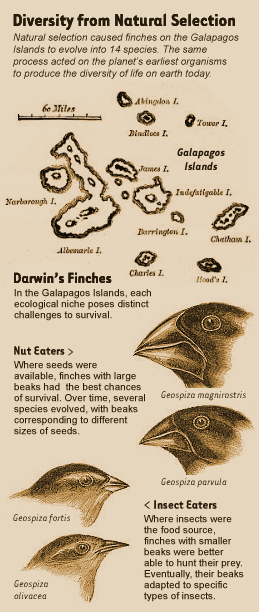|

Scientists estimate that there are between three
million and thirty million species of living things.
Where did this staggering diversity come from?
The answer lies in natural selection, the gradual
adaptation of plants and animals to their environments.
 Natural selection happens because some individuals
within a species have better chances for survival
than others. This diversity is the result of mutations,
random changes in an organism's DNA that can give
one individual advantages over another. These
better-equipped organisms produce the most offspring,
which inherit the traits that allowed their parents
to survive, and the pass on those traits to their
own offspring.
Natural selection happens because some individuals
within a species have better chances for survival
than others. This diversity is the result of mutations,
random changes in an organism's DNA that can give
one individual advantages over another. These
better-equipped organisms produce the most offspring,
which inherit the traits that allowed their parents
to survive, and the pass on those traits to their
own offspring.
Over time, more and more individuals with these
favorable traits survive, while the traits that
might put them at a disadvantage are slowly weeded
out of the gene pool.
At the same time, environmental pressures—from
a change in climate to the loss of a food source—can
offer more specific challenges. As local populations
adapt to the areas in which they live, groups
may split. When two groups can no longer reproduce
with one another, they become separate species.
This is the process that drives evolution, shaping
entire species, rather than individual organisms,
over very long periods of time.
Darwin’s Finches
Naturalist Charles Darwin (1809–1882) first
noticed the evidence for natural selection while
visiting the Galapagos Islands in 1835. On these
isolated islands, Darwin found finches that resembled
those living on the South American continent,
some 1,300 kilometers away. But the Galapagos
finches, he realized, showed a range of beak sizes
that corresponded to the food sources available
where they lived.
Darwin concluded that these birds originated from
a single species that migrated from the mainland
millions of years ago. Since birds faced distinct
challenges depending on where they settled, finches
with different traits survived in different locations.
Through the process of natural selection, the
bird populations eventually split into many species,
which still retaining common characteristics.
With little more than a notebook and his own powers
of observation, Darwin collected a host of other
species, and in 1859 published
The Origin
of Species
, which set out the theory of evolution.
Today, biologists still use many of the same simple
techniques that led Darwin to his revolutionary
conclusions.
|
